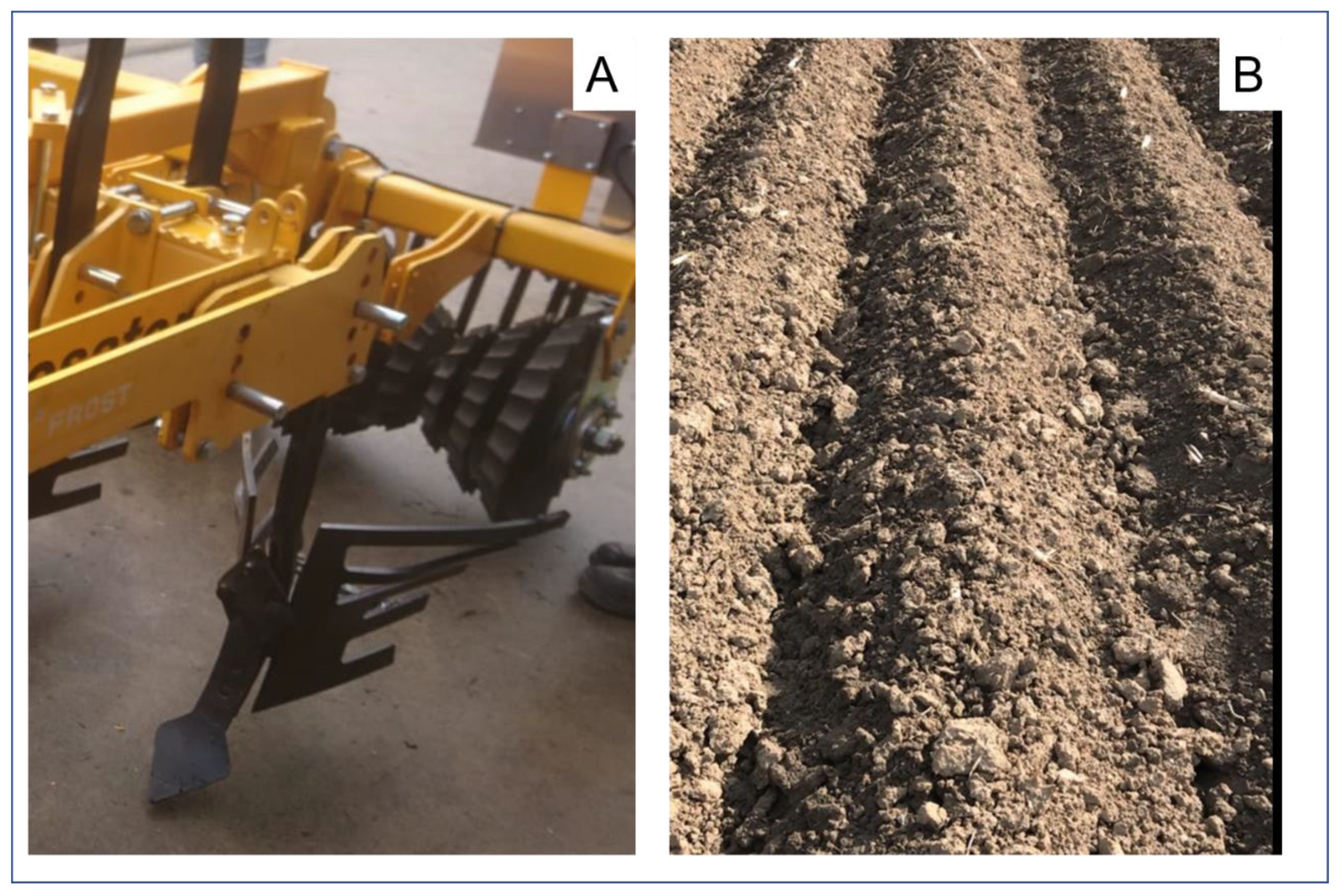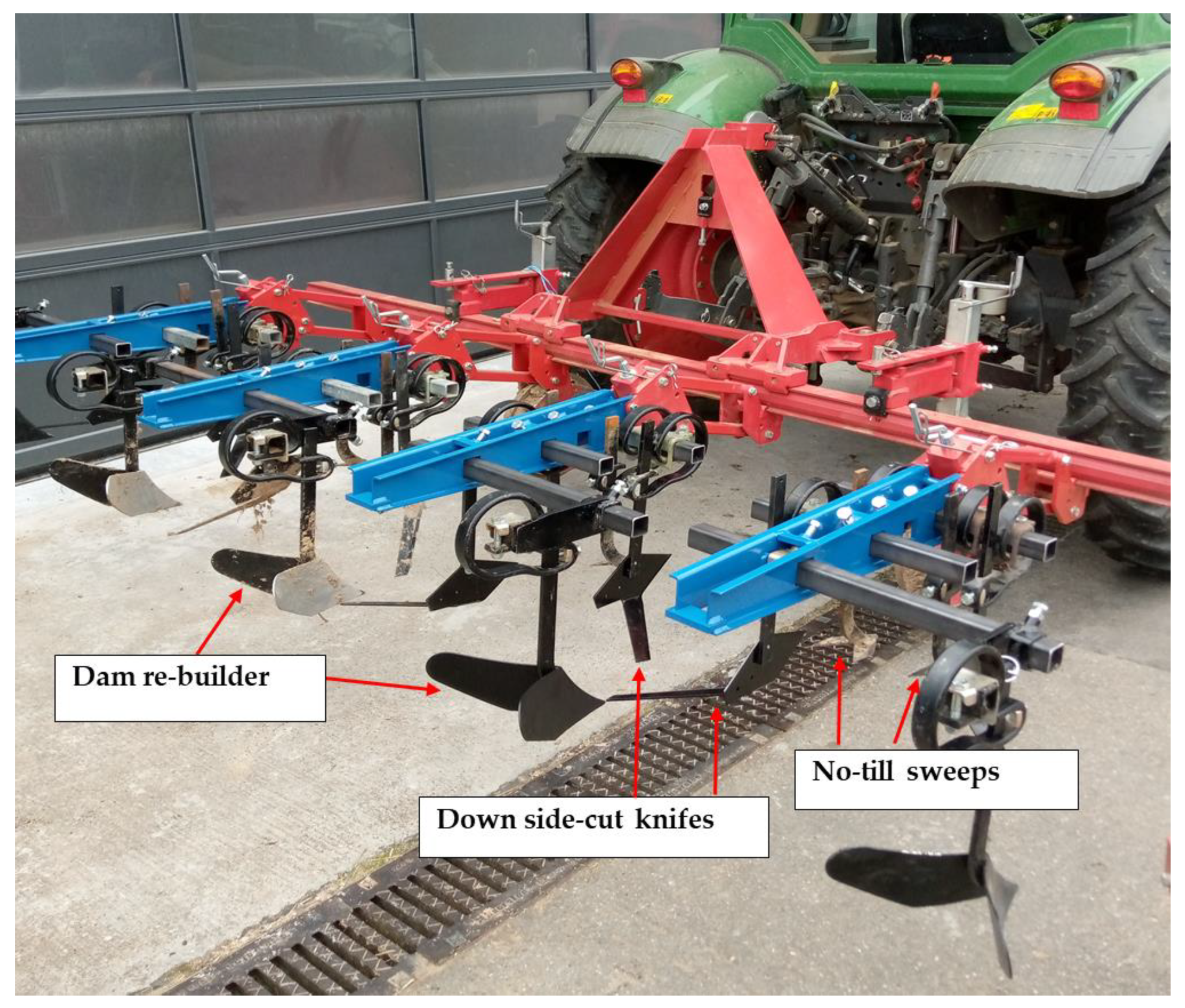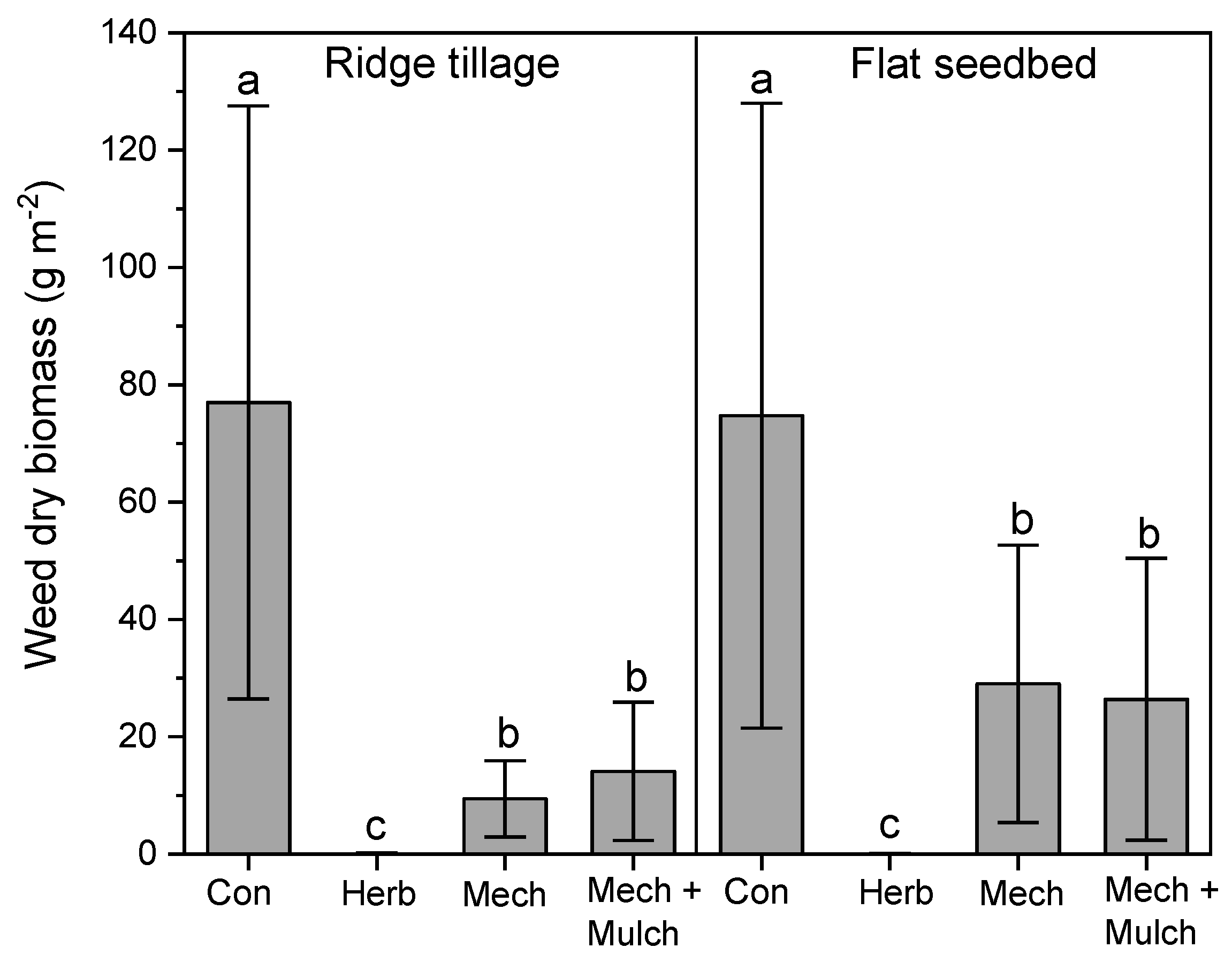Weed Management in Ridge Tillage Systems—A Review
Abstract
:1. Introduction
2. Benefits of Ridge Tillage Systems for Crops
3. Ridge Tillage and Weed Infestations
4. Weed Management in Ridge Tillage Systems
5. Conclusions and Outlook
Author Contributions
Funding
Institutional Review Board Statement
Informed Consent Statement
Data Availability Statement
Acknowledgments
Conflicts of Interest
References
- Liu, S.; Zhang, X.; Liang, A.; Zhang, J.; Müller, C.; Cai, Z. Ridge tillage is likely better than no tillage for 14-year field experiment in black soils: Insights from a 15N-tracing study. Soil Tillage Res. 2018, 179, 38–46. [Google Scholar] [CrossRef]
- Shi, X.H.; Yang, X.M.; Drury, C.F.; Reynolds, W.D.; McLaughlin, N.B.; Zhang, X.P. Impact of ridge tillage on soil organic carbon and selected physical properties of a clay loam in southwestern Ontario. Soil Tillage Res. 2012, 120, 1–7. [Google Scholar] [CrossRef]
- Jernigan, A.B.; Caldwell, B.A.; Cordeau, S.; DiTommaso, A.; Drinkwater, L.E.; Mohler, C.L.; Ryan, M.R. Weed Abundance and Community Composition following a Long-Term Organic Vegetable Cropping Systems Experiment. Weed Sci. 2017, 65, 639–649. [Google Scholar] [CrossRef]
- Mohler, C.L.; Caldwell, B.A.; Marschner, C.A.; Cordeau, S.; Maqsood, Q.; Ryan, M.R.; DiTommaso, A. Weed Seedbank and Weed Biomass Dynamics in a Long-Term Organic Vegetable Cropping Systems Experiment. Weed Sci. 2018, 66, 611–626. [Google Scholar] [CrossRef]
- Ram, H.; Singh, Y.; Saini, K.S.; Kler, D.S.; Timsina, J.; Humphreys, E.J. Agronomic and economic evaluation of permanent raised beds, no tillage and straw mulching for an irrigated maize-wheat system in northwest India. Exp. Agric. 2012, 48, 21–38. [Google Scholar] [CrossRef]
- Onasanya, O.O.; Hauser, S.; Necpalova, M.; Salako, F.K.; Kreye, C.; Tariku, M.; Six, J.; Pypers, P. On-farm assessment of cassava root yield response to tillage, plant density, weed control and fertilizer application in southwestern Nigeria. Field Crops Res. 2021, 262, 108038. [Google Scholar] [CrossRef]
- Hatfield, J. Ridge tillage for corn and soybean production: Environmental quality impacts. Soil Tillage Res. 1998, 48, 145–154. [Google Scholar] [CrossRef]
- Jurik, P. Weed population dynamics in ridge-tilled soybeans with and without herbicides. Leopold Cent. Prog. Rep. 1993, 89, 19. [Google Scholar]
- Klein, R.N.; Wicks, G.A.; Wilson, R.G. Ridge-Till, an Integrated Weed Management System. Weed Sci. 1996, 44, 417–422. [Google Scholar] [CrossRef]
- Buhler, D.D. Influence of Tillage Systems on Weed Population Dynamics and Management in Corn and Soybean in the Central USA. Crop Sci. 1995, 35, 1247–1258. [Google Scholar] [CrossRef]
- Forcella, F.; Lindstrom, M.J. Weed Seed Populations in Ridge and Conventional Tillage. Weed Sci. 1988, 36, 500–503. [Google Scholar] [CrossRef]
- European Commission. Communication from the commision to the european parlament, the council, the european economic and social committee and the committee of the regions EU. In Biodiversity Strategy for 2030 Bringing Nature back into Our Lives; European Commission: Maastricht, The Netherlands, 2020. [Google Scholar]
- Hu, X.; Liang, A.; Yao, Q.; Liu, Z.; Yu, Z.; Wang, G.; Liu, J. Ridge Tillage Improves Soil Properties, Sustains Diazotrophic Communities, and Enhances Extensively Cooperative Interactions Among Diazotrophs in a Clay Loam Soil. Front. Microbiol. 2020, 11, 1333. [Google Scholar] [CrossRef] [PubMed]
- Jiang, X.; Wright, A.L.; Wang, J.; Li, Z. Long-term tillage effects on the distribution patterns of microbial biomass and activities within soil aggregates. Catena 2011, 87, 276–280. [Google Scholar] [CrossRef]
- Mloza-Banda, H.R.; Makwiza, C.N.; Mloza-Banda, M.L. Soil properties after conversion to conservation agriculture from ridge tillage in Southern Malawi. J. Arid. Environ. 2016, 127, 7–16. [Google Scholar] [CrossRef]
- Agbede, T.M. Effect of tillage on soil properties and yam yield on an Alfisol in southwestern Nigeria. Soil Tillage Res. 2006, 86, 1–8. [Google Scholar] [CrossRef]
- Adekiya, A.; Agbede, T.; Ojomo, A. Effects of Tillage Methods on Soil Properties, Nutrient Content, Growth and Yield ofTomato on an Alfisol of Southwestern Nigeria. Am.-Eurasian J. Sustain. Agric. 2009, 3, 348–353. [Google Scholar]
- Zhang, S.; Li, P.; Yang, X.; Wang, Z.; Chen, X. Effects of tillage and plastic mulch on soil water, growth and yield of spring-sown maize. Soil Tillage Res. 2011, 112, 92–97. [Google Scholar] [CrossRef]
- Li, B.; Chen, X.; Shi, X.; Liu, J.; Wei, Y.; Xiong, F. Effects of Ridge Tillage and Straw Mulching on Cultivation the Fresh Faba Beans. Agronomy 2021, 11, 1054. [Google Scholar] [CrossRef]
- Forcella, F.; Lindstrom, M.J. Movement and Germination of Weed Seeds in Ridge-Till Crop Production Systems. Weed Sci. 1988, 36, 56–59. [Google Scholar] [CrossRef]
- Jia, S.; Zhang, X.; Chen, X.; McLaughlin, N.B.; Zhang, S.; Wei, S.; Sun, B.; Liang, A. Long-term conservation tillage influences the soil microbial community and its contribution to soil CO2 emissions in a Mollisol in Northeast China. J. Soils Sediments 2016, 16, 1–12. [Google Scholar] [CrossRef]
- László, P.; Gyuricza, C. Effect of the ridge tillage system on some selected soil physical properties in a maize monoculture. Acta Agron. Hung. 2004, 52, 211–220. [Google Scholar] [CrossRef]
- He, J.; Li, H.; Kuhn, N.J.; Wang, Q.; Zhang, X. Effect of ridge tillage, no-tillage, and conventional tillage on soil temperature, water use, and crop performance in cold and semi-arid areas in Northeast China. Soil Res. 2010, 48, 737. [Google Scholar] [CrossRef]
- Li, N.; Zhou, C.; Sun, X.; Jing, J.; Tian, X.; Wang, L. Effects of ridge tillage and mulching on water availability, grain yield, and water use efficiency in rain-fed winter wheat under different rainfall and nitrogen conditions. Soil Tillage Res. 2018, 179, 86–95. [Google Scholar] [CrossRef]
- Tao, Z.Q.; Peng, S.U.I.; Chen, Y.Q.; Chao, L.I.; Nie, Z.J.; Yuan, S.F.; Jiangtao, S.H.I.; Gao, W.S. Subsoiling and Ridge Tillage Alleviate the High Temperature Stress in Spring Maize in the North China Plain. J. Integr. Agric. 2013, 12, 2179–2188. [Google Scholar] [CrossRef]
- Wang, Q.; Li, H.; He, J.; Li, H.; Sarker, K.K. Effect of ridge culture and no-tillage on soil moisture and maize yield. Trans. Chin. Soc. Agric. Eng. 2012, 28, 146–150. [Google Scholar]
- Clay, D.E.; Schumacher, T.E.; Brix-Davis, K.A. Carbon and nitrogen mineralization in row and interrow areas of chisel and ridge tillage systems. Soil Tillage Res. 1995, 35, 167–174. [Google Scholar] [CrossRef]
- Müller, E.; Wildhagen, H.; Quintern, M.; Heß, J.; Wichern, F.; Joergensen, R.G. Spatial patterns of soil biological and physical properties in a ridge tilled and a ploughed Luvisol. Soil Tillage Res. 2009, 105, 88–95. [Google Scholar] [CrossRef]
- Yuan-zhi, Y. Effects of ridge tillage on photosynthesis and root characters of rice. Chil. J. Agric. Res. 2015, 75, 35–41. [Google Scholar] [CrossRef] [Green Version]
- Negassa, W.; Price, R.F.; Basir, A.; Snapp, S.S.; Kravchenko, A. Cover crop and tillage systems effect on soil CO2 and N2O fluxes in contrasting topographic positions. Soil Tillage Res. 2015, 154, 64–74. [Google Scholar] [CrossRef] [Green Version]
- Gürsoy, S.; Sessiz, A.; Kiliç, H.; Bayram, N. Tillage system and cotton residue management effects on soil physical and chemical properties of an Anatolian clay loam sown within a wheat-cotton sequence. Arch. Agron. Soil Sci. 2011, 57, 391–400. [Google Scholar] [CrossRef]
- Kovar, J.L.; Barber, S.A.; Kladivko, E.J.; Griffith, D.R. Characterization of soil temperature, water content, and maize root distribution in two tillage systems. Soil Tillage Res. 1992, 24, 11–27. [Google Scholar] [CrossRef]
- Thomas, A.L.; Kaspar, T.C. Maize Nodal Root Response to Soil Ridging and Three Tillage Systems. Agron. J. 1995, 87, 853–858. [Google Scholar] [CrossRef]
- Mert, M.; Aslan, E.; Akişcan, Y.; Çalişkan, M.E. Response of cotton (Gossypium hirsutum L.) to different tillage ystems and intra-row spacing. Soil Tillage Res. 2006, 85, 221–228. [Google Scholar] [CrossRef]
- Kropff, M.J.; Spitters, C.J.T. A simple model of crop loss by weed competition from early observations on relative leaf area of the weeds. Weed Res. 1991, 31, 97–105. [Google Scholar] [CrossRef]
- Burrows, W.C.; Larson, W.E. Effect of Amount of Mulch on Soil Temperature and Early Growth of Corn 1. Agron. J. 1962, 54, 19–23. [Google Scholar] [CrossRef]
- Benjamin, J.G.; Blaylock, A.D.; Brown, H.J.; Cruse, R.M. Ridge tillage effects on simulated water and heat transport. Soil Tillage Res. 1990, 18, 167–180. [Google Scholar] [CrossRef]
- Vanasse, A.; Leroux, G.D. Floristic diversity, size, and vertical distribution of the weed seedbank in ridge and conventional tillage systems. Weed Sci. 2000, 48, 454–460. [Google Scholar] [CrossRef]
- Clements, D.R.; Benoit, D.L.; Murphy, S.D.; Swanton, C.J. Tillage Effects on Weed Seed Return and Seedbank Composition. Weed Sci. 1996, 44, 314–322. [Google Scholar] [CrossRef]
- Rasmussen, J.; Bibby, B.M.; Schou, A.P. Investigating the selectivity of weed harrowing with new methods. Weed Res. 2008, 48, 523–532. [Google Scholar] [CrossRef] [Green Version]
- Beck, D.L.; Clay, D.E.; Reitsma, K.D. Best Management Practices for Corn Production in South Dakota: Tillage, Crop Rotations, and Cover Crops; South Dakota State University, College of Agriculture and Biological Sciences, AgBio Communications Unit, Box 2218A: Brookings, South Dakota, 2009. [Google Scholar]
- Gerhards, R. Weed suppression ability and yield impact of living mulch in cereal crops. Agriculture 2018, 8, 39. [Google Scholar] [CrossRef] [Green Version]
- Gerhards, R.; Kollenda, B.; Machleb, J.; Möller, K.; Butz, A.; Reiser, D.; Griegentrog, H.-W. Camera-guided Weed Hoeing in Winter Cereals with Narrow Row Distance. Gesunde Pflanz. 2020, 72, 403–411. [Google Scholar] [CrossRef]
- Gerhards, R.; Weber, J.F.; Kunz, C. Evaluation of weed control efficacy and yield response of inter-row and intra-row hoeing technologies in maize, sugar beet and soybean. Landtechnik 2020, 75, 247–260. [Google Scholar] [CrossRef]
- Home, M.C.W.; Tillett, N.D.; Hague, T.; Godwin, R.J. (Eds.) An Experimental Study of Lateral Positional Accuracy Achieved during Inter-Row Cultivation. In Proceedings of the 5th EWRS Workshop on Physical and Cultural Weed Control, Scuola Superiore Sant’Anna di Studi Universitari e di Perfezionamento, Pisa, Italy, 11–13 March 2002. [Google Scholar]
- Kurstjens, D.A.G.; Kropff, M.J. The impact of uprooting and soil-covering on the effectiveness of weed harrowing. Weed Res. 2001, 41, 211–228. [Google Scholar] [CrossRef]
- Alagbo, O.; Gerhards, R. Development and testing of a new mechanical weeding hoe for re-compacted ridge tillage culture in maize. In Proceedings of the 19th Symposium of the European Weed Research Society (EWRS), Athens, Greece, 20–23 June 2022. [Google Scholar]




| Operations | Targeted Ridge Areas | |||
|---|---|---|---|---|
| In-Row | Top | Slopes | Valleys | |
| RTK–GNSS-controlled ridge tillage using an automatic steering system and GIS | √ | √ | √ | √ |
| Mechanical weeding using furrows or RTK–GNSS or cameras as guiding tools: Pre- and post-emergence harrowing Down side-cut knife No-till sweeps, goose foot hoe, ridge re-builder Torsion tines/finger weeders | ||||
| √ | √ | √ | √ | |
| √ | ||||
| √ √ | √ √ √ | √ | √ | |
| Straws/living mulch seeder after ridge re-building | √ | |||
| Band spraying using RTK–GNSS | √ | √ | ||
Publisher’s Note: MDPI stays neutral with regard to jurisdictional claims in published maps and institutional affiliations. |
© 2022 by the authors. Licensee MDPI, Basel, Switzerland. This article is an open access article distributed under the terms and conditions of the Creative Commons Attribution (CC BY) license (https://creativecommons.org/licenses/by/4.0/).
Share and Cite
Alagbo, O.; Spaeth, M.; Saile, M.; Schumacher, M.; Gerhards, R. Weed Management in Ridge Tillage Systems—A Review. Agronomy 2022, 12, 910. https://doi.org/10.3390/agronomy12040910
Alagbo O, Spaeth M, Saile M, Schumacher M, Gerhards R. Weed Management in Ridge Tillage Systems—A Review. Agronomy. 2022; 12(4):910. https://doi.org/10.3390/agronomy12040910
Chicago/Turabian StyleAlagbo, Oyebanji, Michael Spaeth, Marcus Saile, Matthias Schumacher, and Roland Gerhards. 2022. "Weed Management in Ridge Tillage Systems—A Review" Agronomy 12, no. 4: 910. https://doi.org/10.3390/agronomy12040910
APA StyleAlagbo, O., Spaeth, M., Saile, M., Schumacher, M., & Gerhards, R. (2022). Weed Management in Ridge Tillage Systems—A Review. Agronomy, 12(4), 910. https://doi.org/10.3390/agronomy12040910







